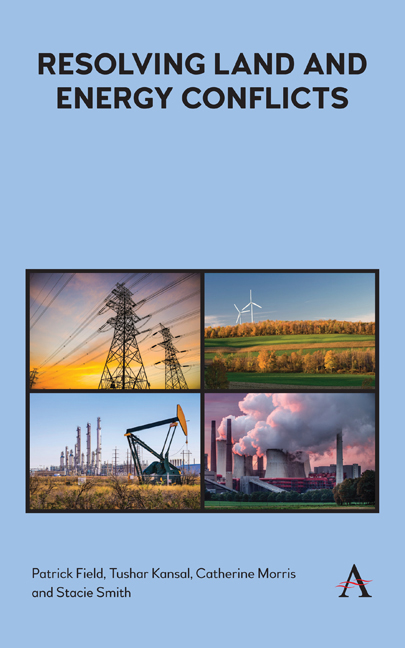Book contents
- Frontmatter
- Contents
- List of Illustrations
- About the Authors
- Acknowledgments
- 1 Introduction: The Complexity and Conflicts of Energy in the US Landscape
- 2 Land-Based Wind Energy Siting: The Not-So-Silent Wind
- 3 Nuclear Waste Siting: Getting Good People to Accept the Bad
- 4 Gas and Oil and Unconventional Shale: The New Old Frontier
- 5 The Linear Challenge: Transmission and Natural Gas Pipelines
- 6 Conclusions and Recommendations
- References
- Index
5 - The Linear Challenge: Transmission and Natural Gas Pipelines
Published online by Cambridge University Press: 29 May 2019
- Frontmatter
- Contents
- List of Illustrations
- About the Authors
- Acknowledgments
- 1 Introduction: The Complexity and Conflicts of Energy in the US Landscape
- 2 Land-Based Wind Energy Siting: The Not-So-Silent Wind
- 3 Nuclear Waste Siting: Getting Good People to Accept the Bad
- 4 Gas and Oil and Unconventional Shale: The New Old Frontier
- 5 The Linear Challenge: Transmission and Natural Gas Pipelines
- 6 Conclusions and Recommendations
- References
- Index
Summary
Introduction
Electricity and natural gas transmission systems are the backbone needed to deliver energy resources to the distribution systems that provide electricity and natural gas to consumers. They are also the part of our energy infrastructure that affects the most people because electricity transmission and distribution and natural gas pipelines cover millions of miles near homes, along highways, across farms and tribal land and through our parks and cities (see Figures 5.1 and 5.2).
The investment needed to expand and modernize this infrastructure to meet today's and tomorrow's evolving needs is daunting. Almost 50 percent of the existing US natural gas transmission system is more than 50 years old and in imminent need of repair or replacement. Furthermore, new sources of natural gas and oil from the “fracking” boom of the past 15 years have required the construction of new pipelines, and the ongoing shift from coal to natural gas for electricity generation is driving demand for more production and more pipelines. On the transmission side, the Edison Electric Institute estimates that the electricity transmission and distribution system needs $900 billion in new investment by 2030. The need for new transmission lines, in particular, is being driven in part by the growing costeffectiveness of remote renewable energy sources such as wind and solar, from which electricity must be carried over long distances to major population centers.
Different regulatory frameworks govern siting decisions for electricity transmission and for natural gas pipelines. In the case of transmission lines, the overlapping authorities over siting of local, state and federal government have in many cases added to the sources of conflict. In contrast, some cite the more streamlined and clear jurisdiction of the federal government in pipeline siting as a model for resolving siting conflicts more effectively.
The source of some of the most intractable conflicts has been and continues to be the disconnect between the costs and the benefits of interstate transmission and pipeline projects. Those living along the lengthy transmission and pipeline corridors often do not enjoy the benefits of lower cost or cleaner power that is carried by these projects.
- Type
- Chapter
- Information
- Resolving Land and Energy Conflicts , pp. 89 - 114Publisher: Anthem PressPrint publication year: 2018

